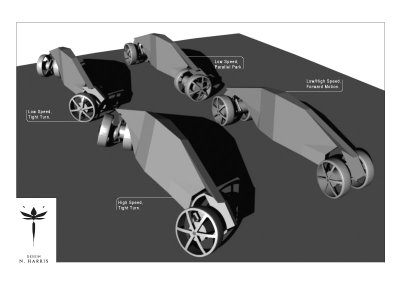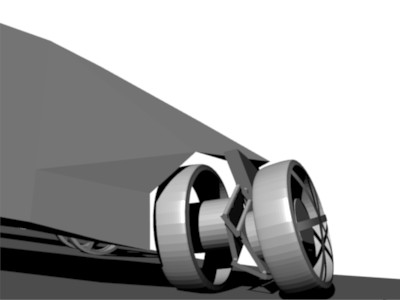Sustainable design theory manifested in products, infrastructure, and graphic representation. A utopian glimpse of a future New Zealand where environmental considerations are of tantamount importance, and society is designed to accommodate the native ecosystem.
Wednesday, December 13, 2006
Thought for Christmas
I think that is a really wonderful statement. It makes me profoundly proud to be an Atheist-Anglican who goes to the Holy Trinity Cathedral of Auckland every Christmas, the church where he is assistant Vicar. I'll think about Maui Dolphins and Kokako next time I listen to Berlioz's L'Adieu des Bergers sung by candlelight.
Tuesday, December 05, 2006
4-Seater Redux


I spent last night re-engineering the 4-seater vehicle. For a number of reasons, I have decided to return to four thinner wheels rather than three wider. Various countries classify any 3-wheeled vehicle as a motorcycle, and thus require helmets; there is a degree of stability inherent in extra wheels, both longitudinally and in terms of cornering grip; the perception of enhanced safety etc.
Total width will remain at circa 1 metre, to take advantage of lane splitting and aerodynamics, with seating for 4. Construction, weight, and various other functional details remain similar.
The drivetrain consists of two units, almost like locomotive boogies. At low speeds, the units twist as a whole, both front and rear, to give a very tight turning circle. Either unit can rotate 90 degrees to allow parallel parking to become very simple- a specialised control would be required to switch into this mode.
At higher speeds, the units would continue to rotate on the horizontal plane, however a degree of tilt would be progressively applied via hydraulics. The tilt ratio would be determined in relation to speed, braking etc. by computer. Note also that the correct turning track for each wheel is provided by the differential built into the tilting mechanism- almost like giant skateboard trucks. Each wheel would have an electric motor positioned near the hub. I have avoided true hub-mounted motors as I believe unsprung weight is a real problem here, and they are actually quite impractical. Rather, these motors and their casings would function as the tilting arm attachment points, as well as the mounting point for suspension.
The resulting vehicle would have aerodynamics vastly superior to conventional cars, be just as safe, much, much lighter, more practical in urban areas, and hopefully even more exciting to drive. Efficiency would be excellent if using Li-ion cells.
A quick collection of links
Sustainable Future is an excellent New Zealand-based resource library, covering a wide array of sustainable news and articles. Very concise, and a valuable source of current information, laid out in specific topic areas.
Sustainable Energy Forum has some interesting links and papers, but most valuable are the PDF EnergyWatch magazines.
Transport.Org.NZ is a website dealing with NZ transport futures, mainly through well-chosen links.
Monday, December 04, 2006
Design Led Futures
Group Tidal: Go Osaki designed a grey water system with 'bubble pumps' which naturally pump water betwen filters, using human movement. The most ingenious idea.
Group Pulse: Daniel Emery's Pixel sink adapts to various tasks to save water. Jason Wright StClair's Kott is a bathtub which also adapts volume to the user.
Group Ka'pil: Jo Lewis' shower is wonderfully elegant, water flow following the occupant around the bathroom by way of pressure sensitive floor tiles.
Group Miyaki: Karen Chang's Glow, a vanity/sink which creates a face-cleansing mist. Lovely semantics.
Fantastic resolution and aesthetics, as well as really innovative design thinking. Inspiring work.
Friday, December 01, 2006
Weekend Reading.
Huehuetortuga Ecovillage, Morelos, Mexico. An example of completely integrated water and wastewater collection, which allows year-round gardening and water supply in an area with an 8-month dry season. I love the use of artificial micro-wetlands to filter grey-water.
Also, Oasis Design, consultants on the above project, have an excellent Q&A.
Of particular interest is their comprehensive guide to grey-water systems.
Also, Greywater treatment and use.
Greywater Wiki.
Living Designs Group provides an overall idea of comparative architecture.
As does Earthship.
New Zealand has fantastic wetland biodiversity- a great native resource for the above processes. And the DOC has a site too.